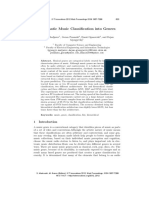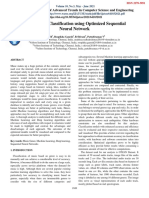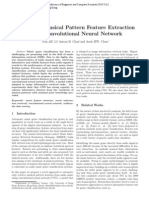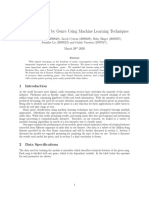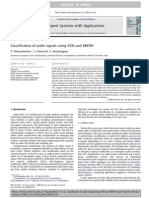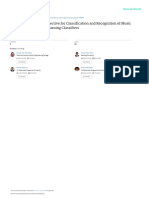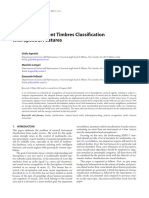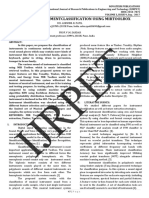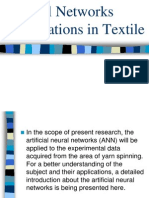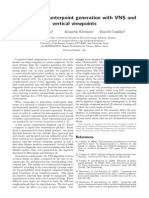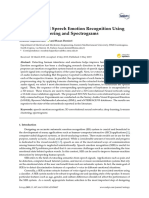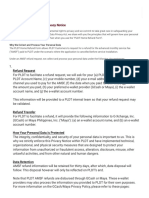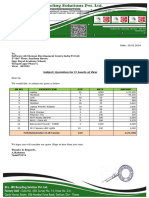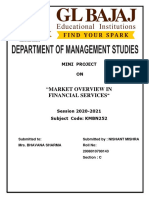Professional Documents
Culture Documents
Music Genre Detection Using Machine Learning Algorithms
Copyright
Available Formats
Share this document
Did you find this document useful?
Is this content inappropriate?
Report this DocumentCopyright:
Available Formats
Music Genre Detection Using Machine Learning Algorithms
Copyright:
Available Formats
Volume 8, Issue 5, May – 2023 International Journal of Innovative Science and Research Technology
ISSN No:-2456-2165
Music Genre Detection using Machine
Learning Algorithms
Karan Rathi1 Manas Bisht2
Department of computer Department of Computer
Science and Engineering, Sharda University, SET Science and Engineering, Sharda University, SET
Greater Noida, UP (India) Greater Noida, UP (India)
Abstract:- Music genre classification is one example of labels, which allows them to classify new, unlabeled pieces
content-based analysis of music signals. Historically, of music into the appropriate genre category. The genres of
human-engineered features were employed to automate music that different communities write or even just listen to
this process, and in the 10-genre classification, 61% can be used to identify them. Different groups and
accuracy was attained. Even yet, it falls short of the 70% communities listen to various types of music. The music's
accuracy that humans are capable of in the identical genre is a key characteristic that distinguishes it from other
activity. Here, we suggest a novel approach that types of music. A regular person cannot recognize the genre
combines understanding of the neurophysiology of the of the music right away after listening to it. But because the
auditory system with research on human perception in distinctions between many genres of music can be hazy,
the classification of musical genres. The technique classifying them is a particularly challenging job. For
involves training a straightforward convolutional neural instance, in a test using a 10-way forced choice problem,
network (CNN) to categorise a brief portion of the music college students were able to classify the music 70%
input. The genre of the song is then identified by accurately after hearing it for just 3 seconds, and the
breaking it up into manageable chunks and combining accuracy remained constant with longer music [1].
CNN's predictions from each individual chunk. The Additionally, the amount of tagged data is sometimes
filters learned in the CNN match the Spectro temporal significantly lower than the data's dimension. For instance,
receptual field (STRF) in humans, and after training, even though the GTZAN dataset used in this work only has
this approach reaches human-level (70%) accuracy. 1000 audio tracks, each audio track is 30 seconds long and
has a sample rate of 22,050 Hz.
I. INTRODUCTION
II. LITRATURE REVIEW
Music plays a very important role in people’s lives.
Music brings like-minded people together and is the glue Numerous research papers on the classification of
that holds communities together. A music genre is a musical genres have extensively employed this kind of
category or classification of music that shares common methodology. Multiple spectrograms obtained from audio
characteristics such as musical style, instrumentation, recordings are used as inputs for CNN, and their patterns are
rhythm, melody, and cultural and historical context. extracted into a 2D convolutional layer with the appropriate
Examples of music genres include rock, pop, hip-hop, filter and kernel sizes [9]. The spectrogram is mentioned in
classical, jazz, blues, country, electronic, folk, and many CNN because the model is good at identifying picture
others. Each genre is defined by a set of conventions that details [8]. Lau proposed applying the Convolutional Neural
distinguish it from other genres and often has a dedicated Network (CNN) model using a preprocessed GTZAN
fan base and industry infrastructure. The boundaries dataset. Each song's extracted Mel-Frequency Cepstrum
between genres can sometimes be blurred, and new genres Coefficient (MFCC) spectrogram was included in the
can emerge through a fusion of existing ones or by dataset. Additionally, the feature descriptions for the audio
incorporating elements of different styles. Music genre excerpts in 3 seconds and 30 seconds were included in a
detection is the process of automatically identifying the separate.csv file [8]. Then, using Keras, he created a CNN
genre of a piece of music using algorithms and machine architecture with 5 convolutional blocks. Each block
learning techniques. The goal of music genre detection is to contained a convolutional layer with a 3x3 filter and a 1x1
classify a piece of music into one or more predefined stride, a max pooling with a 2x2 windows size and a 2x2
categories based on its acoustic features, such as timbre, stride, and a Rectifying Linear Unit (ReLU) function to
rhythm, harmony, and melody. Music genre detection is display the probabilities for 10 music genres; the genre with
used in various applications such as music recommendation the highest probability was picked as the input's
systems, music streaming platforms, and content-based classification label [8]. Twenty MFCCs were trained on 30-
music retrieval systems. The process typically involves second and 3-second pieces of music, three CNN models
analyzing the audio signal using signal processing were built on spectrograms, and a classification test was run
techniques to extract relevant features, which are then fed on the test sets following training [8]. As Lau noted, there
into machine learning models trained on labeled datasets. was a problem with the training datasets because the 3-
The models learn to recognize patterns and associations second dataset did not match the number of genres in the
between the extracted features and the corresponding genre sample Nevertheless, some genres featured fewer or more
IJISRT23MAY473 www.ijisrt.com 630
Volume 8, Issue 5, May – 2023 International Journal of Innovative Science and Research Technology
ISSN No:-2456-2165
samples than the standard (1000) [10]. The Short-term data.
Fourier Transform (STFT) spectrograms, which are
composed of different sequences of spectrogram vectors B. Machine Learning Tecniques
across time, were used by Yu et al to establish the CNN We used several models such as KNN, SVM, Naïve
method [10]. In their paper, two datasets were mentioned: Bayes, Decision tree and NN.
Extended Ballroom and GTZAN. Yu et al. separated each
song from both datasets into 18 smaller parts in 3 seconds KNN (K-Nearest Neighbours):
with 50% overlaps, increasing the data size set for each This machine learning method and algorithm can be
genre label by 18 times over the original [10]. The STFT applied to both classification and regression tasks. K-Nearest
spectrograms were examined with an analysis size of Neighbours uses the labels of a predetermined number of
513x128 and the train-validate-test ratio was 8:1:1 [10]. In data points to create a prediction about the class that the
order to capture discrete audio properties reflected in the target data point belongs to. We utilised K-Nearest
STFT spectrograms and lessen source loss, pooling kernels Neighbours (KNN), a conceptually straightforward yet
and convolution filters were designed in small sizes in the incredibly effective technique, to train our model. Avoid
first few layers of the CNN model [10]. Athulya and Sindhu combining SI and CGS units, such as magnetic field in
came up with the idea of building a 2D Convolutional oersteds and current in amperes. Due to the fact that
Neural Network (CNN). They extracted the audio samples equations do not balance dimensionally, this frequently
from the GTZAN dataset into several types of spectrograms causes confusion. If mixed units must be used, be sure to
using the Librosa tool. These spectrograms served as binary specify them for each quantity you include in an equation.
inputs for the 2D CNN model developed with the Keras
framework. The layers were also created using the SVM (Support Vector Machine):
TensorFlow framework [6]. Displayed was a 2D This approach for supervised learning is utilised for
convolutional layer using input measurements of both regression and classification. Finding a hyperplane in an
128x128x1. The inputs to the max-pooling layer, which N-dimensional space that clearly classifies data points is the
would operate a matrix half the size of the input layer, were basic goal of SVM.
represented by a 2D NumPy array [6]. The overall number
of convolutional layers was 5, with a max-pooling layer, a Naïve Bayes:
stride of 2, and a 2x2 kernel size. Next, the output from each This model that makes predictions based on
layer would be inserted into a fully linked layer that also had probability, and is an algorithm based on the idea of the
inputs in the form of a flattened and shrinking matrix size Bayes theorem. It can also be used to solve classification
[6]. The SoftMax function, which was included at the end of problems.
the output layer, produced the probability output. The
architecture achieved 94% accuracy. Similar to this, Nandy Decision Tree:
and Agrawal suggested a 2D CNN with a 1D kernel based The non-parametric supervised learning approach used
on spectrograms generated from audio snippets in the Free for classification and regression applications is the decision
Music Archive (FMA) dataset. The model produced an tree. It is organised hierarchically, with a root node,
output of a 5000-length vector from an input dimension of branches, internal nodes, and leaf nodes.
500x1500. Convolution layer blocks, a batch normalization
layer, an activation layer, and, if practical, a max-pooling NN (Neural Networks):
layer were all included in the construction of the CNN. The The foundation of deep learning algorithms is a subset
2D CNN model was trained, validated, and tested 80:10:10 of machine learning known as artificial neural networks
times, with a dropout parameter of 0.5 [1]. The model beat (ANNs), often known as ANNs. Their design is influenced
previous models from comparable research articles, by the structure of the human brain, replicating how synapses
performing with an accuracy rate of 76.2% and a logloss are sent and received in the brain.
rate of 0.7543. An F1-Score greater than 0.7 indicated that
the model was increasingly performing well at categorizing C. Data Set
musical genres. We have used the data set called FMA medium which
consists of fma_medium.zip: 25,000 tracks of 30s, 16
III. METHODOLOGY unbalanced genres (22 GiB). FMA stands for free music
archive.
A. Pre-Processing
We used data sets from the FMA medium, which are IV. EXPERIMENTAL RESULT
25000 songs from 8 different genres that have been
compressed to 30 seconds apiece. We have divided the SVM:
unsorted datasets into only four genres based on the meta
data, namely: Hip-Hop, rock, pop, and folk One audio clip Table 1 SVM
was fed into our programme, and its spectral centroid,
spectral bandwidth, spectral roll off, MFCC (Mel-frequency
Cepstral Coefficients), Zero crossing rate, and RMSE (Root
mean Square Energy) properties were extracted from it and
saved into a new CSV file. Thus, obtaining a set of tagged
IJISRT23MAY473 www.ijisrt.com 631
Volume 8, Issue 5, May – 2023 International Journal of Innovative Science and Research Technology
ISSN No:-2456-2165
SVM with Oversampling Techniques: KNN with Undersampling Techniques:
Table 2 SVM with Oversampling Techniques Table 5 KNN with Undersampling Techniques
TREE:
Table 6 TREE
SVM with Undersampling Techniques:
Table 2 SVM with Undersampling Techniques
TREE with Oversampling Techniques:
Table 7 TREE with Oversampling Techniques
KNN:
Table 3 KNN
TREE with Undersampling Techniques:
Table 8 TREE with Undersampling Techniques
KNN with Oversampling Techniques:
Table 4 KNN with Oversampling Techniques
IJISRT23MAY473 www.ijisrt.com 632
Volume 8, Issue 5, May – 2023 International Journal of Innovative Science and Research Technology
ISSN No:-2456-2165
NAÏVE BAYES: Random Forest with Oversampling Techniques:
Table 9 NAÏVE BAYES Table 13 Random Forest with Oversampling Techniques
NAÏVE BAYES with Oversampling Techniques:
Table 10 NAÏVE BAYES with Oversampling Techniques
Random Forest with Undersampling Techniques:
NAÏVE BAYES with Undersampling Techniques:
Table 14 Random Forest with Undersampling Techniques
Table 11 NAÏVE BAYES with Undersampling Techniques
Random Forest:
Table 12 Random Forest
Oversampling and Undersampling Used:
SYNTHETIC MINORITY OVERSAMPLING (SMOTE):
This statistical method is employed to evenly increase
the number of examples in your dataset. SMOTE
creates new instances from inputs of minority cases that
already exist.
IJISRT23MAY473 www.ijisrt.com 633
Volume 8, Issue 5, May – 2023 International Journal of Innovative Science and Research Technology
ISSN No:-2456-2165
SMOTE-NC: It is used to generate synthetic data to RANDOM OVERSAMPLER: Machine learning uses the
oversample a minority target class in an imbalanced method of random oversampling to balance unbalanced
dataset. datasets. One class contains significantly fewer
ADASYN: The major benefits of this technique, which examples than the other(s) in an unbalanced dataset.
creates synthetic data, are duplicating minority data and This may result in a biassed model that does not
producing extra data for "harder to learn" examples. adequately represent the minority class. This is
BORDERLINE-SMOTE: This algorithm classifies any addressed by random oversampling, which duplicates
minority observation as a noise point if all the examples from the minority class until the dataset is
neighbours are of majority class, and such an balanced.
observation is ignored while creating synthetic data.
K-MEANS SMOTE: is an oversampling method for V. FUTURE WORK
class-imbalanced data. It aids classification by
generating minority class samples in safe and crucial There are several future scopes that can be explored to
areas of the input space. improve its performance. Here are some possible
SVM SMOTE: is a Variant of SMOTE algorithm which approaches:
use an SVM algorithm to detect sample to use for
generating new synthetic samples. Data Augmentation:
CLUSTER CENTROIDS: is a method that undersamples One way to improve the performance of a genre
the majority class by substituting the cluster centroid of detection model is to increase the size of the training dataset
a KMEANS algorithm for a cluster of majority sample by generating additional examples from the existing ones
locations. through data augmentation techniques. For example, the
CONDENSED NEAREST NEIGHBOUR: Condensed audio signals can be randomly time-stretched, pitch-shifted,
nearest neighbour which is also known as the Hart or filtered to create variations of the same piece of music
algorithm is an algorithm designed to reduce the data that can help the model learn more robust representations of
set for k-NN classification. It selects the set of the genre features.
prototypes U from the training data, such that 1NN with
U can classify the examples almost as accurately as Feature Engineering:
1NN does with the whole dataset. Another way to improve the performance of a genre
EDITED NEASREST NEIGHBOUR (ENN): This detection model is to extract more informative features from
method works by finding the K-nearest neighbour of the audio signals that capture the essential characteristics of
each observation first, then check whether the majority each genre. This can be achieved by using more
class from the observation's K-nearest neighbour is the sophisticated signal processing techniques or by
same as the observation's class or not. incorporating domain-specific knowledge about music
REPEATED EDITED NEASRESTNEIGHBOUR: This theory and composition into the feature extraction process.
method repeats the ENN algorithm several times; it
under samples based on the repeated edited nearest Ensemble Methods:
neighbour. Ensemble methods combine the outputs of multiple
AIIKNN: It removes all examples from the dataset that models to make more accurate predictions than any single
were classified incorrectly. model alone. By training multiple genre detection models
INSTANCEHARDNESS THRESHOLD: This is an under with different architectures, hyperparameters, or training
data, and then combining their outputs through voting,
sampling method that was built to tackle imbalanced
averaging, or stacking, we can leverage the diversity of the
classifications.
models' predictions to improve the overall accuracy of the
NEARMISS: It refers to a group of undersampling
ensemble.
techniques that choose examples depending on how
close majority class and minority class examples are to
one another. Transfer Learning:
Transfer learning involves reusing pre-trained models
ONESIDEDSELECTION: Condensed Nearest
that were originally trained on large datasets for related
Neighbour (CNN) Rule and Tomek Links are two
tasks to improve the performance of a new model with
undersampling techniques that are combined to create
limited training data. By fine-tuning a pre-trained model on
One-Sided Selection, or OSS. The CNN approach is
a smaller genre detection dataset, we can leverage the pre-
used to eliminate redundant examples from the interior
existing knowledge captured by the model to improve its
of the density of the majority class, whereas the Tomek
accuracy on the target task.
Links method is used to eliminate noisy examples on
the class boundary.
Hybrid Approaches:
RANDOMUNDERSAMPLER: It undersamples the
Hybrid approaches combine multiple techniques from
majority class(es) by randomly picking samples with or
the above methods to create more sophisticated genre
without replacements.
detection models. For example, a hybrid model could use a
TOMEKLINKS:Tomek links are pairs of instances of pre-trained deep learning model for feature extraction,
opposite classes who are their own nearest neighbours. followed by a support vector machine (SVM) classifier
trained on augmented data, and then an ensemble method to
IJISRT23MAY473 www.ijisrt.com 634
Volume 8, Issue 5, May – 2023 International Journal of Innovative Science and Research Technology
ISSN No:-2456-2165
combine the predictions of multiple SVM models with
different hyperparameters.
VI. CONCLUSION
In this paper we propose the KNN algorithm with
EditedNearestNeighbor undersampling and only one
neighbour to be far more accurate than the remaining
algorithms along with their over and under sampling. Due to
our limited computational resources and time we were not
able to execute neural network on our dataset.
REFERENCES
[1]. Chatziagapi, A., Paraskevopoulos, G., Sgouropoulos,
D., Pantazopoulos, G., Nikandrou, M.,
Giannakopoulos, T., ... & Narayanan, S. (2019,
September). Data Augmentation Using GANs for
Speech Emotion Recognition. In Interspeech (pp.
171-175).
[2]. Biswas, R., & Ghattamaraju, N. (2019). An effective
analysis of deep learning based approaches for audio
based feature extraction and its visualization.
Multimedia Tools and Applications, 78, 23949-
23972.
[3]. Lu, Y. C., Wu, C. W., Lerch, A., & Lu, C. T. (2016,
August). Automatic Outlier Detection in Music Genre
Datasets. In ISMIR (pp. 101-107).
[4]. Fell, M., & Sporleder, C. (2014, August). Lyrics-
based analysis and classification of music. In
Proceedings of COLING 2014, the 25th international
conference on computational linguistics: Technical
papers (pp. 620-631).
[5]. Van Mieghem, L. C. F. (2020). Music Genre
Detection: with Neural Networks.
IJISRT23MAY473 www.ijisrt.com 635
You might also like
- Music Genre Classification For Indian MuDocument9 pagesMusic Genre Classification For Indian MuKakasdNo ratings yet
- CNN Music ClassificationDocument6 pagesCNN Music ClassificationMr BenniganNo ratings yet
- Music Genre Classification: Instrumentation and Control Engineering MINOR PROJECT (2019-2023)Document17 pagesMusic Genre Classification: Instrumentation and Control Engineering MINOR PROJECT (2019-2023)ShiwaliNo ratings yet
- Song Classification Using Machine LearningDocument7 pagesSong Classification Using Machine LearningIJRASETPublicationsNo ratings yet
- Song Classification Using Machine LearningDocument7 pagesSong Classification Using Machine LearningIJRASETPublicationsNo ratings yet
- MusicAL - Go - Algorithmic Music GenerationDocument9 pagesMusicAL - Go - Algorithmic Music GenerationIJRASETPublicationsNo ratings yet
- Paper14324Document9 pagesPaper14324Roorroo GabrummàaNo ratings yet
- Automatic Music Classification Into GenrDocument10 pagesAutomatic Music Classification Into GenrNUR LIYANA ZAKARIANo ratings yet
- Musical Genre Classification Using Support Vector MachinesDocument5 pagesMusical Genre Classification Using Support Vector MachinesKakasdNo ratings yet
- Music Genre Classification Using Machine LearningDocument3 pagesMusic Genre Classification Using Machine LearningEditor IJTSRDNo ratings yet
- Music Genre Classification Using Optimized Sequential Neural NetworkDocument10 pagesMusic Genre Classification Using Optimized Sequential Neural NetworkVelumani sNo ratings yet
- Automatic Musical Pattern Feature Extraction Using Convolutional Neural NetworkDocument5 pagesAutomatic Musical Pattern Feature Extraction Using Convolutional Neural Networkapi-25914596No ratings yet
- A Comparative Study On Content - Based Music Genre ClassificationDocument8 pagesA Comparative Study On Content - Based Music Genre ClassificationthorsetNo ratings yet
- Music Generation Using Recurrent Neural NetworksDocument9 pagesMusic Generation Using Recurrent Neural NetworksIJRASETPublicationsNo ratings yet
- Urban Sound ClassificationDocument6 pagesUrban Sound Classificationamit kNo ratings yet
- Music Genre ClassificationDocument6 pagesMusic Genre ClassificationharshukaytNo ratings yet
- Music Genre Classification Using A Hierarchical Long Short Term Memory (LSTM) ModelDocument6 pagesMusic Genre Classification Using A Hierarchical Long Short Term Memory (LSTM) ModelOscar SanchezNo ratings yet
- HerthertyherDocument6 pagesHerthertyhersmdfiasdngfNo ratings yet
- Classifying Music by Genre Using Machine Learning TechniquesDocument10 pagesClassifying Music by Genre Using Machine Learning TechniquesJacob CytronNo ratings yet
- FMA-V8-October - CSSE .V4Document14 pagesFMA-V8-October - CSSE .V4Thành Chu BáNo ratings yet
- Nietjet 0602S 2018 003Document5 pagesNietjet 0602S 2018 003NIET Journal of Engineering & Technology(NIETJET)No ratings yet
- Automatic Classification of Musical Audio Signals Employing Machine Learning ApproachDocument11 pagesAutomatic Classification of Musical Audio Signals Employing Machine Learning Approachscrt5No ratings yet
- Irjet Music Information Retrieval and GeDocument8 pagesIrjet Music Information Retrieval and GeMurthy PolisettyNo ratings yet
- Music Transcription Modelling and Composition Using Deep LearningDocument16 pagesMusic Transcription Modelling and Composition Using Deep LearningIoana GrozavNo ratings yet
- Jurnal - 2Document6 pagesJurnal - 2farizallawi24No ratings yet
- Seminar 2Document34 pagesSeminar 2roydebopriyaNo ratings yet
- Classifying audio signals using SVM and neural networksDocument7 pagesClassifying audio signals using SVM and neural networkspurple raNo ratings yet
- dnmr8 DH DC PDFDocument1 pagednmr8 DH DC PDFDorien HerremansNo ratings yet
- E29paperDocument7 pagesE29paperNhã TriếtNo ratings yet
- Audio Information Retrieval (AIR) Tools: George TzanetakisDocument12 pagesAudio Information Retrieval (AIR) Tools: George TzanetakisMai NguyễnNo ratings yet
- Musical_Instrument_Timbres_Classification_with_SpectumDocument10 pagesMusical_Instrument_Timbres_Classification_with_Spectumkrazen017No ratings yet
- Deep Convolutional Neural Networks For Environmental Sound ClassificationDocument7 pagesDeep Convolutional Neural Networks For Environmental Sound ClassificationIJRASETPublicationsNo ratings yet
- Smart Data Processing For Energy Harvesting System Using Ambient Noise With Deep LearningDocument5 pagesSmart Data Processing For Energy Harvesting System Using Ambient Noise With Deep LearningEditor in ChiefNo ratings yet
- Incze 2018Document6 pagesIncze 2018Prasad HiwarkarNo ratings yet
- Cs6601 Project 2 PaperDocument4 pagesCs6601 Project 2 PapersamNo ratings yet
- A Comparison of Sound Segregation Techniques For Predominant Instrument Recognition in Musical Audio SignalsDocument6 pagesA Comparison of Sound Segregation Techniques For Predominant Instrument Recognition in Musical Audio SignalsRaiatea MoeataNo ratings yet
- Musical Tones Classification Using Machine LearningDocument6 pagesMusical Tones Classification Using Machine LearningIJRASETPublicationsNo ratings yet
- Cross-Correlation of Music and Floor DataDocument5 pagesCross-Correlation of Music and Floor Datanavkul1No ratings yet
- Music Genre Classification Using Machine Learning: Prajwal R, Shubham Sharma, Prasanna Naik, Mrs. Sugna MKDocument5 pagesMusic Genre Classification Using Machine Learning: Prajwal R, Shubham Sharma, Prasanna Naik, Mrs. Sugna MKchaudharykrishna818No ratings yet
- Laden 1989Document16 pagesLaden 1989CaractacusFigulus100% (1)
- Musical Instrumentclassification Using MirtoolboxDocument5 pagesMusical Instrumentclassification Using MirtoolboxJournalNX - a Multidisciplinary Peer Reviewed JournalNo ratings yet
- Deep Learning Approach to Chord DetectionDocument7 pagesDeep Learning Approach to Chord DetectionD Ban ChoNo ratings yet
- The Columbine Massacre - Barack Obama - Zionist Wolf in Sheep's (PDFDrive)Document18 pagesThe Columbine Massacre - Barack Obama - Zionist Wolf in Sheep's (PDFDrive)Roman TilahunNo ratings yet
- Electric Guitar Playing Style Feature fusion using Filter BanksDocument8 pagesElectric Guitar Playing Style Feature fusion using Filter Banksaryan.nair704No ratings yet
- University of California PressDocument41 pagesUniversity of California PressSoad KhanNo ratings yet
- Neural Networks Applications in TextileDocument34 pagesNeural Networks Applications in TextileSatyanarayana PulkamNo ratings yet
- 3 Deec 51 Ae 28 Ba 013 A 4Document5 pages3 Deec 51 Ae 28 Ba 013 A 4Carrot ItCsNo ratings yet
- Mathematics 10 04427Document19 pagesMathematics 10 04427Juan Carlos Juarez VargasNo ratings yet
- Article - April 26th VersionDocument4 pagesArticle - April 26th VersionLiza OlivasNo ratings yet
- Muzic Genre ClassificationDocument4 pagesMuzic Genre Classificationazura netNo ratings yet
- Classification of Lung Sounds Using CNNDocument10 pagesClassification of Lung Sounds Using CNNHan ViceroyNo ratings yet
- Bird Song Recognition Through Spectrogram Processing and LabelingDocument8 pagesBird Song Recognition Through Spectrogram Processing and Labelingdmzy2No ratings yet
- 2019 - Beats, Downbeats, and Functional Segment Annotations of Western Popular Music.Document8 pages2019 - Beats, Downbeats, and Functional Segment Annotations of Western Popular Music.Rahul Kodag100% (1)
- On Learning To Identify Genders From Raw Speech Signal Using CnnsDocument5 pagesOn Learning To Identify Genders From Raw Speech Signal Using CnnsharisbinziaNo ratings yet
- First Species Counterpoint Generation With VNS and Vertical ViewpointsDocument1 pageFirst Species Counterpoint Generation With VNS and Vertical ViewpointsDorien HerremansNo ratings yet
- WIMP2017 Martinez-RamirezReissDocument4 pagesWIMP2017 Martinez-RamirezReissśūnyatāNo ratings yet
- Overlapped Music Segmentation Using A New Effective Feature and Random ForestsDocument9 pagesOverlapped Music Segmentation Using A New Effective Feature and Random ForestsIAES IJAINo ratings yet
- Music Genre Classification Based On Local Feature Selection Using A Self-Adaptive Harmony Search AlgorithmDocument17 pagesMusic Genre Classification Based On Local Feature Selection Using A Self-Adaptive Harmony Search AlgorithmAfonso PalandriNo ratings yet
- 3D CNN-Based SERDocument17 pages3D CNN-Based SERAshwani RatheeNo ratings yet
- Structural Analysis Systems: Software — Hardware Capability — Compatibility — ApplicationsFrom EverandStructural Analysis Systems: Software — Hardware Capability — Compatibility — ApplicationsRating: 5 out of 5 stars5/5 (1)
- Comparatively Design and Analyze Elevated Rectangular Water Reservoir with and without Bracing for Different Stagging HeightDocument4 pagesComparatively Design and Analyze Elevated Rectangular Water Reservoir with and without Bracing for Different Stagging HeightInternational Journal of Innovative Science and Research TechnologyNo ratings yet
- Diabetic Retinopathy Stage Detection Using CNN and Inception V3Document9 pagesDiabetic Retinopathy Stage Detection Using CNN and Inception V3International Journal of Innovative Science and Research TechnologyNo ratings yet
- The Utilization of Date Palm (Phoenix dactylifera) Leaf Fiber as a Main Component in Making an Improvised Water FilterDocument11 pagesThe Utilization of Date Palm (Phoenix dactylifera) Leaf Fiber as a Main Component in Making an Improvised Water FilterInternational Journal of Innovative Science and Research TechnologyNo ratings yet
- Advancing Healthcare Predictions: Harnessing Machine Learning for Accurate Health Index PrognosisDocument8 pagesAdvancing Healthcare Predictions: Harnessing Machine Learning for Accurate Health Index PrognosisInternational Journal of Innovative Science and Research TechnologyNo ratings yet
- Dense Wavelength Division Multiplexing (DWDM) in IT Networks: A Leap Beyond Synchronous Digital Hierarchy (SDH)Document2 pagesDense Wavelength Division Multiplexing (DWDM) in IT Networks: A Leap Beyond Synchronous Digital Hierarchy (SDH)International Journal of Innovative Science and Research TechnologyNo ratings yet
- Electro-Optics Properties of Intact Cocoa Beans based on Near Infrared TechnologyDocument7 pagesElectro-Optics Properties of Intact Cocoa Beans based on Near Infrared TechnologyInternational Journal of Innovative Science and Research TechnologyNo ratings yet
- Formulation and Evaluation of Poly Herbal Body ScrubDocument6 pagesFormulation and Evaluation of Poly Herbal Body ScrubInternational Journal of Innovative Science and Research TechnologyNo ratings yet
- Terracing as an Old-Style Scheme of Soil Water Preservation in Djingliya-Mandara Mountains- CameroonDocument14 pagesTerracing as an Old-Style Scheme of Soil Water Preservation in Djingliya-Mandara Mountains- CameroonInternational Journal of Innovative Science and Research TechnologyNo ratings yet
- The Impact of Digital Marketing Dimensions on Customer SatisfactionDocument6 pagesThe Impact of Digital Marketing Dimensions on Customer SatisfactionInternational Journal of Innovative Science and Research TechnologyNo ratings yet
- A Review: Pink Eye Outbreak in IndiaDocument3 pagesA Review: Pink Eye Outbreak in IndiaInternational Journal of Innovative Science and Research TechnologyNo ratings yet
- Auto Encoder Driven Hybrid Pipelines for Image Deblurring using NAFNETDocument6 pagesAuto Encoder Driven Hybrid Pipelines for Image Deblurring using NAFNETInternational Journal of Innovative Science and Research TechnologyNo ratings yet
- Design, Development and Evaluation of Methi-Shikakai Herbal ShampooDocument8 pagesDesign, Development and Evaluation of Methi-Shikakai Herbal ShampooInternational Journal of Innovative Science and Research Technology100% (3)
- A Survey of the Plastic Waste used in Paving BlocksDocument4 pagesA Survey of the Plastic Waste used in Paving BlocksInternational Journal of Innovative Science and Research TechnologyNo ratings yet
- Cyberbullying: Legal and Ethical Implications, Challenges and Opportunities for Policy DevelopmentDocument7 pagesCyberbullying: Legal and Ethical Implications, Challenges and Opportunities for Policy DevelopmentInternational Journal of Innovative Science and Research TechnologyNo ratings yet
- Hepatic Portovenous Gas in a Young MaleDocument2 pagesHepatic Portovenous Gas in a Young MaleInternational Journal of Innovative Science and Research TechnologyNo ratings yet
- Explorning the Role of Machine Learning in Enhancing Cloud SecurityDocument5 pagesExplorning the Role of Machine Learning in Enhancing Cloud SecurityInternational Journal of Innovative Science and Research TechnologyNo ratings yet
- Navigating Digitalization: AHP Insights for SMEs' Strategic TransformationDocument11 pagesNavigating Digitalization: AHP Insights for SMEs' Strategic TransformationInternational Journal of Innovative Science and Research TechnologyNo ratings yet
- Perceived Impact of Active Pedagogy in Medical Students' Learning at the Faculty of Medicine and Pharmacy of CasablancaDocument5 pagesPerceived Impact of Active Pedagogy in Medical Students' Learning at the Faculty of Medicine and Pharmacy of CasablancaInternational Journal of Innovative Science and Research TechnologyNo ratings yet
- Automatic Power Factor ControllerDocument4 pagesAutomatic Power Factor ControllerInternational Journal of Innovative Science and Research TechnologyNo ratings yet
- Mobile Distractions among Adolescents: Impact on Learning in the Aftermath of COVID-19 in IndiaDocument2 pagesMobile Distractions among Adolescents: Impact on Learning in the Aftermath of COVID-19 in IndiaInternational Journal of Innovative Science and Research TechnologyNo ratings yet
- Review of Biomechanics in Footwear Design and Development: An Exploration of Key Concepts and InnovationsDocument5 pagesReview of Biomechanics in Footwear Design and Development: An Exploration of Key Concepts and InnovationsInternational Journal of Innovative Science and Research TechnologyNo ratings yet
- Studying the Situation and Proposing Some Basic Solutions to Improve Psychological Harmony Between Managerial Staff and Students of Medical Universities in Hanoi AreaDocument5 pagesStudying the Situation and Proposing Some Basic Solutions to Improve Psychological Harmony Between Managerial Staff and Students of Medical Universities in Hanoi AreaInternational Journal of Innovative Science and Research TechnologyNo ratings yet
- The Effect of Time Variables as Predictors of Senior Secondary School Students' Mathematical Performance Department of Mathematics Education Freetown PolytechnicDocument7 pagesThe Effect of Time Variables as Predictors of Senior Secondary School Students' Mathematical Performance Department of Mathematics Education Freetown PolytechnicInternational Journal of Innovative Science and Research TechnologyNo ratings yet
- Drug Dosage Control System Using Reinforcement LearningDocument8 pagesDrug Dosage Control System Using Reinforcement LearningInternational Journal of Innovative Science and Research TechnologyNo ratings yet
- Securing Document Exchange with Blockchain Technology: A New Paradigm for Information SharingDocument4 pagesSecuring Document Exchange with Blockchain Technology: A New Paradigm for Information SharingInternational Journal of Innovative Science and Research TechnologyNo ratings yet
- Enhancing the Strength of Concrete by Using Human Hairs as a FiberDocument3 pagesEnhancing the Strength of Concrete by Using Human Hairs as a FiberInternational Journal of Innovative Science and Research TechnologyNo ratings yet
- Formation of New Technology in Automated Highway System in Peripheral HighwayDocument6 pagesFormation of New Technology in Automated Highway System in Peripheral HighwayInternational Journal of Innovative Science and Research TechnologyNo ratings yet
- Supply Chain 5.0: A Comprehensive Literature Review on Implications, Applications and ChallengesDocument11 pagesSupply Chain 5.0: A Comprehensive Literature Review on Implications, Applications and ChallengesInternational Journal of Innovative Science and Research TechnologyNo ratings yet
- Intelligent Engines: Revolutionizing Manufacturing and Supply Chains with AIDocument14 pagesIntelligent Engines: Revolutionizing Manufacturing and Supply Chains with AIInternational Journal of Innovative Science and Research TechnologyNo ratings yet
- The Making of Self-Disposing Contactless Motion-Activated Trash Bin Using Ultrasonic SensorsDocument7 pagesThe Making of Self-Disposing Contactless Motion-Activated Trash Bin Using Ultrasonic SensorsInternational Journal of Innovative Science and Research TechnologyNo ratings yet
- Quot - Leak Tester BP Ridwan - PTI Cosmetics - 08apr21Document6 pagesQuot - Leak Tester BP Ridwan - PTI Cosmetics - 08apr21mario gultomNo ratings yet
- Azure InvoiceDocument2 pagesAzure InvoiceAnkit SambhareNo ratings yet
- Toshiba LCD TV-DVD 17HLV85 - SVMDocument134 pagesToshiba LCD TV-DVD 17HLV85 - SVMJose Angel Coronel SanchezNo ratings yet
- 5G-NR Protocol Stack Testing TrainingDocument6 pages5G-NR Protocol Stack Testing Trainingmansoor 31 shaikhNo ratings yet
- Installation: Indoor UnitDocument10 pagesInstallation: Indoor UnitJohan FloresNo ratings yet
- PLDT REFUND FORMDocument4 pagesPLDT REFUND FORMKitchenHacksNo ratings yet
- Retinopathy Report 2023Document83 pagesRetinopathy Report 2023Hydra ANINo ratings yet
- Amna Synopsis-1Document9 pagesAmna Synopsis-1Rehan AhmadNo ratings yet
- ISO 30302 2015 SpanishDocument50 pagesISO 30302 2015 SpanishThant AungNo ratings yet
- Strand & Funtowicz Springer2017Document14 pagesStrand & Funtowicz Springer2017Roger StrandNo ratings yet
- SPG/SSG Election Report: Attachment 1Document4 pagesSPG/SSG Election Report: Attachment 1Nexus BallesterosNo ratings yet
- HP Compaq 6910p Compal LA-3261p UMA Rev 1A SchematicDocument55 pagesHP Compaq 6910p Compal LA-3261p UMA Rev 1A Schematicbbbbbb1987No ratings yet
- Lec4-5 QDocument4 pagesLec4-5 QBashir Emad kadimNo ratings yet
- Data Sheet Ultrastar DC Ha210Document2 pagesData Sheet Ultrastar DC Ha210Marian DiaconescuNo ratings yet
- Substations-Pdf Parte3 PDFDocument76 pagesSubstations-Pdf Parte3 PDFCopr'esunaestafa EditorialdemierdaNo ratings yet
- 4 CP NS-01 BD Draft Part 2 Vol.2 EM Version 11 FINAL REV ADocument1,357 pages4 CP NS-01 BD Draft Part 2 Vol.2 EM Version 11 FINAL REV Asamarendra parida100% (1)
- Catálogo EIXO ZFDocument27 pagesCatálogo EIXO ZFOdirley JonesNo ratings yet
- Airframe and SystemsDocument104 pagesAirframe and SystemsVivek Baskar50% (2)
- RatioandRegressionMethodofEstimation Lecture7 10Document30 pagesRatioandRegressionMethodofEstimation Lecture7 10mrpakistan444No ratings yet
- BV261 - U Type Butterfly ValveDocument2 pagesBV261 - U Type Butterfly ValveFAIYAZ AHMEDNo ratings yet
- Banshee S03E04 1080p BluRay x264-MRSKDocument63 pagesBanshee S03E04 1080p BluRay x264-MRSKGeorge Alexandru RomanNo ratings yet
- Blank Letterhead..... PDF - 20240120 - 143356 - 0000Document1 pageBlank Letterhead..... PDF - 20240120 - 143356 - 0000jrsrecyclingltdNo ratings yet
- 3BUA000135R5001 DCI ConfigDocument34 pages3BUA000135R5001 DCI ConfigCristi CrseNo ratings yet
- BS en 12405-3-2015Document82 pagesBS en 12405-3-2015Doiciel100% (1)
- MFL Floormap - How To Scan and Get DataDocument18 pagesMFL Floormap - How To Scan and Get DataNguyen PhucNo ratings yet
- Producing Cleaned-Up and In-Betweened DrawingsDocument10 pagesProducing Cleaned-Up and In-Betweened DrawingsErika C. Delos SantosNo ratings yet
- Foliant VEGA 400A Installation ManualDocument18 pagesFoliant VEGA 400A Installation ManualAlexandruNo ratings yet
- Mini Project On ''Market Overview On Financial Services'' Nishant Mishra 2008010700143Document40 pagesMini Project On ''Market Overview On Financial Services'' Nishant Mishra 2008010700143Sagar MishraNo ratings yet
- Accounting & Finance Professional: Uzair Ahmed KhanDocument5 pagesAccounting & Finance Professional: Uzair Ahmed KhanmedicotNo ratings yet
- SERBIAN - UOU 4-7-2 Limestone System Rev ADocument139 pagesSERBIAN - UOU 4-7-2 Limestone System Rev ADalibor SimicNo ratings yet







